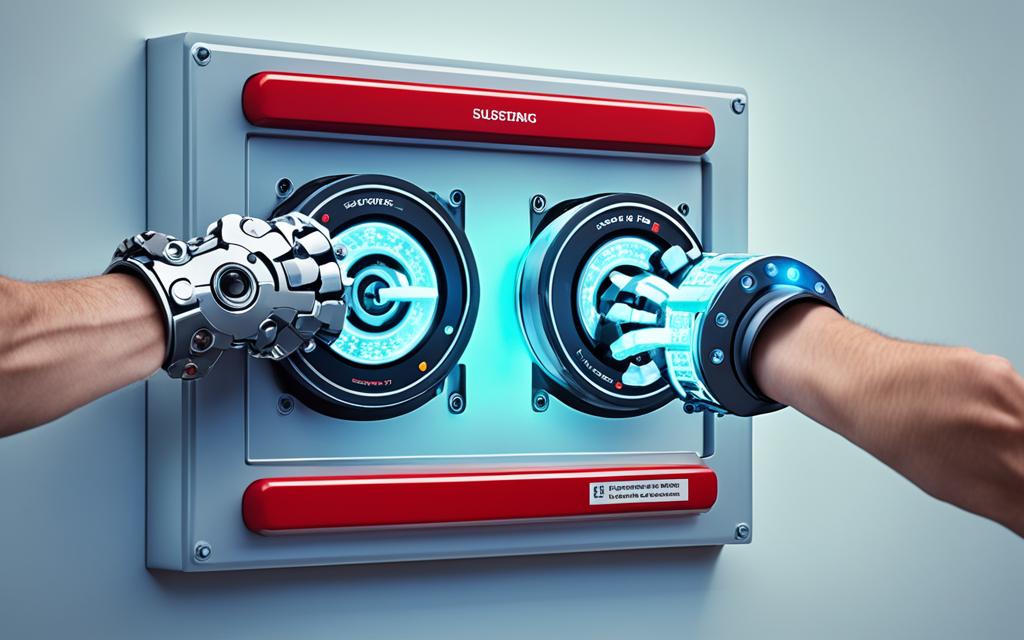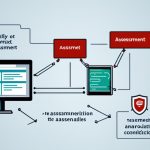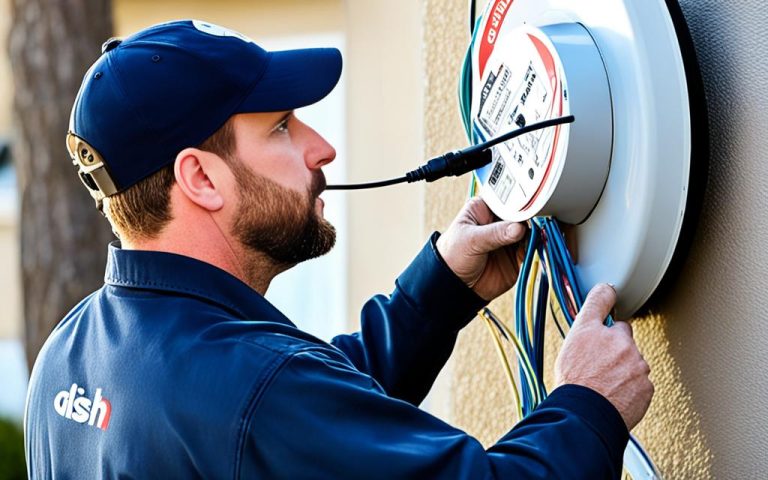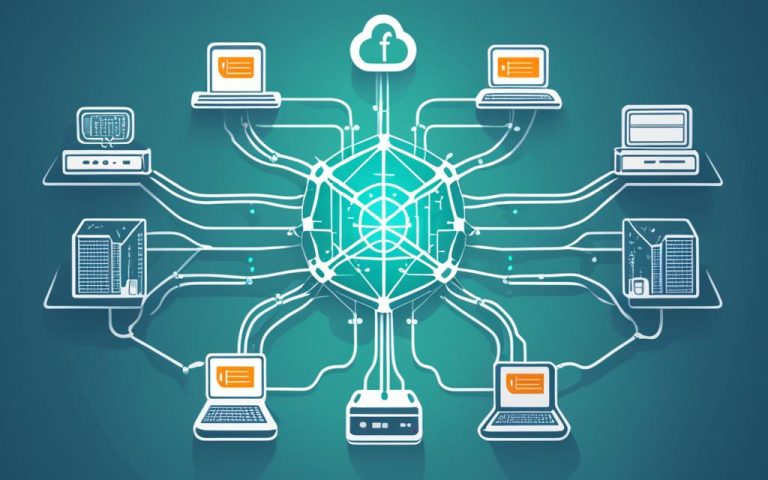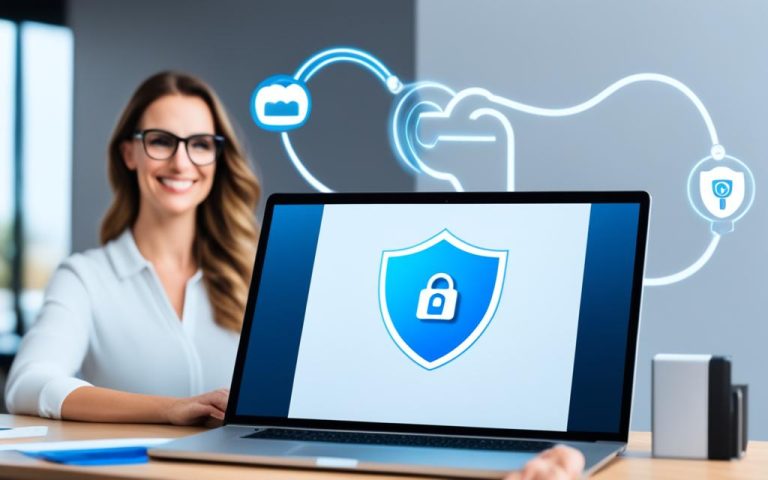Network security authentication is key to keeping sensitive data safe. It checks who is accessing the network. This makes sure only the right people can get in, keeping the network safe.
Authentication has many goals. It proves who is on the network, controlling who gets in. This stops unauthorized access and reduces the chance of data theft. It also logs what users do, helping track down any odd behavior.
There are many ways to authenticate, each with its own level of security and ease. Knowledge-Based Authentication is often used but is not very secure because of attacks and tricks (source)1. But, using Two-factor and Multi-factor authentication makes things much safer (source)1. Biometric and Single Sign-On systems also balance security with ease of use, using new tech to make logging in better (source)1.
Choosing the right authentication for a network means looking at what the network needs. It’s important to put these methods into the network and teach employees about them. This helps make the network safer for everyone1.
Keeping up with new threats is key to staying safe. By using the latest tech and checking for weaknesses, companies can stay ahead of hackers. This keeps the network secure1.
Key Takeaways:
- Network security authentication checks who is on the network, making sure only the right people can access sensitive data.
- Methods like Knowledge-Based and Two-factor authentication offer different levels of security, with Biometric and Single Sign-On systems balancing security and ease.
- Training employees and regularly checking authentication methods are key to a strong network security setup.
Understanding Network Security Authentication
Network security authentication is key to keeping networks safe. It makes sure only the right users and devices get in.
Authentication checks who you are before letting you into a network. It’s the first step in keeping out unwanted visitors and threats.
In today’s world, where cybercrime is growing, it’s crucial to know about network security authentication. This knowledge helps protect data and keep networks safe.
Network security authentication uses different methods and tech to check who you are and what device you’re using. This helps keep the network secure.
The Importance of Identity Verification
Checking who you are is a big part of network security authentication. It builds trust and makes sure only the right people and devices get to sensitive stuff.
Over time, how we check identities has changed. Early systems asked for a username and password or a certificate from a RADIUS server2.
Later, new systems added more ways to control access. They used VLANs, ARP control, and 802.1X to make things safer2.
Then, automation came into play. Devices could automatically follow security rules2.
Now, we have advanced ways to manage devices and handle security issues2.
One main goal is to stop unauthorized devices from getting into networks2.
It also helps track IP addresses and connect them to devices. This makes finding and dealing with threats easier2.
Network Integrity and Asset Management
Network security authentication also helps keep networks running smoothly and manage assets well.
It gives detailed info about devices like who made them and where they are. This helps in managing and keeping them safe2.
It also makes WLANs safer by supporting 802.1X authentication2.
This stops unauthorized access points and keeps users from making their own2.
It makes sure devices follow security rules by checking things like antivirus software. It also separates devices that don’t meet standards2.
And it keeps an eye on devices that aren’t updated, making the network safer2.
Network Security Authentication vs. Firewalls
It’s important to know the difference between network security authentication and firewalls. Firewalls watch over network traffic. Network security authentication checks who’s talking to whom inside the network2.
Both are key to network security but do different jobs. Understanding network security authentication is key to keeping data safe and networks secure.
| Statistical Data | Reference Number |
|---|---|
| First-generation NAC required devices to provide a username/password or certificate for approval by a RADIUS server. | 2 |
| Second-generation NAC incorporated access control methods like VLAN quarantining and ARP based control in addition to 802.1X. | 2 |
| Third-generation NAC introduced automation where agents automatically configured devices to comply with security policies. | 2 |
| Fourth-generation NAC focused on advanced device fingerprinting for managing assets and automated responses to vulnerabilities. | 2 |
| NAC addresses the issue of unauthorized device entry in networks by denying access to unapproved devices. | 2 |
| NAC assists in detailed IP tracking by monitoring and associating IP addresses with connected endpoints. | 2 |
| NAC helps in organized asset management by providing endpoint details such as manufacturer, product name, location, etc. | 2 |
| NAC improves WLAN security by supporting 802.1X authentication for better wireless security. | 2 |
| NAC prevents unauthorized access points within the network and rogue access points created by users. | 2 |
| NAC ensures compliance by monitoring essential settings like antivirus software and isolating non-compliant devices. | 2 |
| NAC monitors and isolates unpatched endpoints to enhance the security of the network. | 2 |
| NAC differs from firewalls in that firewalls control communication between networks, while NAC controls communication between endpoints within a network. | 2 |
The Significance of Authentication
Authentication is key to keeping data and networks safe. It makes sure only the right people can get in and keeps sensitive info safe. By checking who you are, it stops unauthorized access and keeps data and networks secure.
Two-factor authentication (2FA) greatly lowers the chance of someone getting in without permission, even if they have your password3. It’s hard for companies to set up, dealing with passwords, making users follow rules, and finding a good balance between safety and ease3. But, it’s worth it because it makes sure only the right people can see company secrets, keeping the business’s good name safe3.
Authentication is also key to keeping data private by lowering the chance of data theft and protecting privacy rights3. With new tech, things like biometrics, behavior checks, and zero-trust models are making security better and more flexible3. Teaching users about good security habits is also important, helping them spot and deal with security risks3.
In our connected world, making sure IoT devices are secure is more important than ever. It stops unauthorized access that could harm networks and keep data safe3. Finding the right balance between security and ease is key to making sure authentication doesn’t slow things down3.
Key Statistics on the Significance of Authentication:
| Statistical Data | Source |
|---|---|
| Two-factor authentication (2FA) reduces the risk of unauthorized access, even if passwords are compromised | Link 1 |
| Authentication is crucial in ensuring secure access to information, with a server needing to verify the identity of who accesses the data | Link 2 |
| Biometrics, such as fingerprints or facial recognition, offer highly secure authentication methods due to their unique physical characteristics | Link 3 |
Types of Authentication Methods
Choosing the right way to secure your network is key. There are many ways to keep systems and data safe. These include:
Knowledge-Based Authentication
KBA is a common way to check who you are. It asks for things you know, like passwords or PINs. But, it can be risky because people often write down their passwords4. It’s important to keep KBA safe and use strong passwords.
Possession-Based Authentication
This method uses something you have to prove who you are. Things like security tokens or mobile devices are used. These items are hard to fake, adding security. But, it’s key to keep these items safe.
Inherence-Based Authentication
This method uses your unique traits to check who you are. It includes things like fingerprints or facial recognition. It’s getting popular because it’s easy and accurate. Plus, some methods can’t be stolen4. It’s great for people who forget passwords or need extra security.
Multi-Factor Authentication
MFA uses more than one way to check who you are. It combines knowledge, possession, or inherence-based methods. It’s seen as very secure5. For example, you might need a password, fingerprint, and token to get into something.
Using different authentication methods helps protect your network well. Each method has its own strengths and weaknesses. Choosing the right mix can make your security stronger.
Now, let’s look at some stats on authentication methods:
| Type of Authentication | Statistical Data |
|---|---|
| Password-Based Login | Password-Based Login is losing favor due to its inefficiency in today’s multi-service usage environment5. |
| Multi-Factor Authentication (MFA) | Multi-Factor Authentication (MFA) is considered one of the most trusted authentication methods following traditional password-based login5. |
| Biometric Authentication | Biometric authentication technologies, such as fingerprint scanning, are gaining popularity for their user-friendly and accurate nature5. |
| Certificate-Based Authentication | Certificate-based authentication uses electronic digital identities to verify users and devices, enhancing security5. |
| Token-Based Authentication | Token-Based Authentication reduces the need for repeated credential input, offering a more streamlined login experience for various applications5. |
| Single Sign-On (SSO) | Single Sign-On (SSO) authentication simplifies user access by requiring only one login for multiple applications, leading to improved efficiency and reduced support calls for password resets5. |
| Two-Factor Authentication (2FA) | Two-Factor Authentication is a popular security measure that requires users to provide two factors for access, enhancing security significantly5. |
These stats show how important different authentication methods are for keeping networks safe. It’s crucial to think about these when picking your security plan.
Implementing Network Security Authentication
Setting up network security authentication is key to keeping your data safe. It’s important to look at your network’s needs, pick the right authentication methods, and make sure they work well together. Training users and keeping your methods updated is also crucial.
Assessing Network Needs
Before you start, figure out what your network needs for security. Think about the data it handles and any weak spots. This helps you know how secure you need to be and what authentication methods to use.
Selecting Authentication Methods
There are many ways to authenticate, each with its own level of security. Choose ones that fit your security rules and what your users need. Using multi-factor authentication, which includes passwords, biometrics, and tokens, adds extra security6.
Next Generation Firewalls (NGFW) help block malware and attacks7. Zero Trust Network Access (ZTNA) limits access to what users need for their jobs7. Remote access VPN keeps telecommuters and mobile users safe with extra checks and encrypted data7. Data Loss Prevention (DLP) stops sensitive info from getting out7. Intrusion Prevention Systems (IPS) catch or stop security attacks7. Sandboxing checks files and code for danger in a safe space7. Hyperscale Network Security lets you quickly add or remove security as needed7. Cloud Network Security with SDN and SD-WAN keeps modern data centers safe and flexible7.
Integration and Training
After picking your methods, make sure they fit into your network. This means setting up the right hardware and software. Training your users well helps them understand why and how to use these methods.
Regular Review and Updates
Security threats are always changing, so you need to keep your methods up to date. Stay on top of the latest security news and best practices. Updating and patching your systems helps protect against new threats6.
By doing network security authentication right, you can make your organization much safer. It’s an ongoing task that needs careful planning, the right tools, training, and regular updates to keep your network secure.
Table: Network Security Authentication Methods
| Authentication Method | Description |
| — | — |
| Multi-factor Authentication | Combines multiple factors (e.g., passwords, biometrics, security tokens) for enhanced security |
| Next Generation Firewalls (NGFW) | Focuses on blocking malware and application-layer attacks7|
| Zero Trust Network Access (ZTNA) | Restricts user access to resources based on their roles7|
| Remote access VPN | Provides secure access for telecommuters and mobile users through encryption and multi-factor authentication7|
| Data Loss Prevention (DLP) | Aims to prevent the exposure of sensitive information outside of an organization7|
| Intrusion Prevention Systems (IPS) | Detects or prevents network security attacks7|
| Sandboxing | Observes files and code for malicious behavior in a safe environment7|
| Hyperscale Network Security | Enables rapid deployment and scaling to meet changing security demands7|
| Cloud Network Security (SDN and SD-WAN) | Protects modern data centers with greater flexibility7|Sources:
- Checkpoint – What is Network Security
- IBM – Network Security
- Network Insight – Implementing Network Security
Challenges and Solutions in Network Security Authentication
Implementing network security authentication is tough for companies. They struggle to balance security with ease of use. Strong security is key to protect data and stop unauthorized access. But, if it’s too hard, users might get frustrated and not follow the rules8.
Dealing with lost or stolen authentication factors is another big challenge. When something like a password or token gets lost, quick action is needed. Having clear steps to disable or replace these items helps keep the system safe8.
Stopping cyber threats is a top priority. With hackers getting smarter, companies must keep updating their security. Using email security, network segmentation, and other methods helps protect against attacks8.
Balancing Security and Usability
Finding the right balance between security and ease of use is key. Strong security is needed to keep data safe, but it can’t be too hard for users. By making authentication both secure and easy, companies can reduce security risks and keep users happy9.
Dealing with Lost or Stolen Authentication Factors
Lost or stolen authentication factors are a big problem. When something like a password gets lost, acting fast is crucial. Having steps to quickly disable or replace these items helps keep the system secure9.
Protecting Against Cyber Threats
Keeping networks safe from cyber threats is vital. Using email security and other methods helps protect against attacks. These steps prevent unauthorized access and keep data safe9.
For companies, focusing on network security is crucial for their safety. Cyber attacks can cause big financial losses and harm their reputation. With more people working from home, network security is even more important to protect business operations9.
Network security is the first line of defense against cyber threats. By making the authentication process strong, companies can keep data safe and build trust. Cyber attacks can disrupt business and cost a lot, so security is key9.
A strong network security setup lets companies focus on their goals without worrying about security issues. By using good security measures and following security rules, companies can protect their assets and reduce risks. Security rules also help with everyday tasks and make sure companies follow laws like GDPR or ISO 270019.
| Authentication Method | Description |
|---|---|
| Email Security | Prevents unauthorized access to email accounts and filters fraudulent emails to the Spam folder |
| Network Segmentation | Categorizes network traffic for better security enforcement, with endpoint identity preferred for classifications |
| Access Control | Restricts network access to authorized users based on device and user identification, providing security policies |
| Sandboxing | Uses isolated environments to securely open files, monitoring code or files to identify potential threats |
| Cloud Network Security | Protects data stored in the cloud from unauthorized access while ensuring data visibility and security |
| Web Security | Prevents access to harmful websites, manages internet usage, and safeguards web gateways both locally and in the cloud |
| Intrusion Prevention System | Monitors network activities for malicious behavior and attempts to block or stop malicious activities |
| Antivirus and Anti-malware Software | Prevents the entry of malicious software into the network and fights against it once detected |
| Firewalls | Monitor and control incoming and outgoing network traffic based on predefined security rules, enhancing network security |
| Application Security | Safeguards applications against data theft and exploitation, including security measures during development |
| Wireless Security | Secures wireless networks from exploits and unauthorized access, protecting against potential attacks |
| Mobile Device Security | Controls device connections to networks, with a focus on mobile device and app security |
| Industrial Network Security | Protects Industrial Control Systems (ICS) from cyber threats, ensuring complete visibility into Operational Technology (OT) security status |
| VPN Security | Encrypts network communication over the internet, allowing secure connections between devices and networks |
The Business Angle: Why Network Security Authentication Matters
Network security authentication is key for modern businesses. It keeps sensitive company data safe and ensures data privacy. This method makes sure only the right people can see important info. It helps avoid data breaches and keeps a company’s good name.
Cyber threats are a big deal for businesses10. Things like unauthorized access and data breaches can cause big problems. These issues can lead to money loss, harm to reputation, and legal trouble10. With cyber threats getting more complex, having strong network security is a must10.
Keeping online transactions safe is a big part of network security10. Customers want to know their info is secure. This makes them trust a business more. A secure online space lets customers shop and do business safely.
Network security also helps stop threats from inside the company10. By using strong security checks, businesses can stop unauthorized access and misuse from within.
It’s not just about keeping data safe. It’s also about protecting important systems like power grids and healthcare facilities10. These systems are key to keeping people safe. A security breach could cause big problems, so protecting them is crucial.
Using different security tools is important for keeping data safe10. Tools like firewalls and encryption help a lot. A mix of these tools creates a strong defense against threats1011.
Keeping software updated is also key to security10. It helps fix weaknesses that hackers could use. Staying current with security updates is vital for protecting networks well.
In short, network security authentication is vital for businesses. It means using strong security, protecting important systems, and keeping customer data safe. By focusing on security, businesses can stop data breaches, keep data private, and build trust with customers. This leads to a safer and more successful business.
Looking Ahead: The Future of Network Security Authentication
The future of network security authentication looks promising with new tech12. Trends like biometric, behavioral analytics, and zero-trust security are changing the game12. It’s important for companies to keep up to stay safe from cyber threats.
The human touch is key in keeping networks secure, especially with more devices online12. With so many devices connected, keeping things safe gets harder. Teaching users about security is more important than ever to protect data12.
Finding a balance between security and ease of use is crucial12. Companies must make sure their security is strong but still easy for users. This is especially true for industries where constant access is needed.
Enhancing Security with Emerging Technologies
“The future of network security authentication lies in leveraging emerging technologies to address the evolving threat landscape.” – Cybersecurity Expert
Biometric authentication is a big step forward in security12. It uses things like fingerprints or facial recognition for top-notch security12. But, it also makes some users worry about privacy12. In certain fields, like secure access, biometrics is a must.
Behavioral analytics is also becoming a big deal in security12. It looks at how users act to spot and stop security risks12. This helps keep networks safer and stops unauthorized access.
Zero-trust security is another new trend12. It treats every user and device as a potential threat, no matter where they are in the network. Only after checking and okaying can users get to network resources12.
The Evolution of Access Control
Access control has changed a lot over time to keep up with security needs12. Rules from groups like GDPR and HIPAA make sure access is strict in certain fields13.
Old ways of logging in, like passwords, aren’t enough anymore14. The future is moving towards stronger methods, like token-based authentication12. This adds more security but might make help desks busier12.
Protocols like RADIUS and OAuth 2.0 help keep access safe in different areas12. They manage remote access, keep user info safe, and secure wireless and web apps12.
The Challenges and Solutions Ahead
The future of network security has its ups and downs12. Facing new cyber threats is key to keeping data safe12. Staying ahead with things like constant checks and threat info helps a lot12.
Thinking about the user experience is also vital12. It’s important to make security strong but not too hard for users. Companies should aim for smooth, easy ways to log in without slowing things down12.
As companies grow, handling more users and devices is a big challenge12. Keeping things running smoothly without losing security is key.
Managing passwords securely is another big task, especially in places where data is very private12.
The Path Forward
Using zero-trust ideas makes network security easier12. By breaking down networks, companies can make sure only authorized people get in12.
The future of network security is looking up with new tech and trends13. AI and machine learning will make access control better by looking at user actions and network oddities13. Blockchain and decentralized identity are also on the rise to boost security and privacy13.
As more devices join the IoT, keeping them secure is more important than ever13. Network security needs to keep up to protect our connected world13.
The future of network security is bright, but we’ll face challenges14. Network operators are working hard to keep things safe, but they’ll need to keep up with new tech and threats14.
| Future Trends | Statistical Data121314 |
|---|---|
| Biometric Authentication | Offers a high level of security but raises privacy concerns among users |
| Zero-Trust Security Model | Adopting a zero-trust approach ensures secure and authorized access to network resources |
| Behavioral Analytics | By analyzing user behavior patterns, potential security threats can be detected |
| Token-Based Authentication | Provides additional security through time-sensitive codes but may increase help desk demands |
| Compliance Regulations | Mandate stringent access control measures in industries handling confidential data |
| Evolving Threat Landscape | Addressing evolving cyber threats is crucial for data security |
| AI and Machine Learning | Expected to streamline access control decisions and enhance network security |
| Blockchain and Decentralized Identity | Gaining traction to enhance security and privacy in access control |
| IoT Security | Crucial as access control adapts to the growing number of connected devices |
Conclusion
Network security authentication is key to keeping out unauthorized access and protecting data from cyber threats15. With more threats out there, strong authentication methods are a must. This includes using passwords, biometrics, two-factor authentication, and encryption keys to check who you are.
These methods make things safer and make it easier for users to get into systems. They keep high security levels while making things simpler for everyone.
Authentication is the first defense against network threats. It lets only the right people or devices in, cutting down on unauthorized access and security risks15. EAP and RADIUS make sure users are who they say they are across different networks.
Secure communication is also vital. Using TLS and SSH keeps data safe from being intercepted or changed during its journey15.
Authentication is key to stopping identity theft and keeping networks safe from threats. It’s a critical part of keeping data and networks secure15.
By using smart authentication, companies can make things better for users and boost productivity. Single Sign-On (SSO) makes logging in easier by using one set of credentials for many apps16. Two-Factor Authentication (2FA) adds an extra layer of security by asking for two kinds of proof of identity. Biometric authentication uses things like fingerprints or facial recognition for strong security.
Even with challenges like password issues and new threats, companies can stay ahead by using multi-factor authentication and encryption16. As technology gets better, we’ll see more in biometrics, behavioral analytics, and zero-trust authentication1716.
Keeping up with network security authentication is an ongoing task. Companies need to stay informed and proactive. By focusing on strong authentication and security awareness, they can build a safe network against cyber threats17. Remember, it’s not just about following rules but also about keeping data safe and earning trust from customers and stakeholders.
| Statistics | Source |
|---|---|
| Network security authentication is crucial in protecting against unauthorized access and data breaches with the increasing threat of cyber attacks to safeguard sensitive information. | 15 |
| A study by the Ponemon Institute revealed that implementing multi-factor authentication can reduce the risk of data breaches by 99%. | 17 |
| Single Sign-On (SSO) simplifies authentication for users, allowing access to multiple applications with a single set of credentials, balancing user experience with security requirements. | 16 |
Conclusion
Network security authentication is key to keeping sensitive info safe and stopping unauthorized access. Companies use methods like passwords, biometrics, two-factor authentication, and encryption keys to check who is accessing their systems15. This helps lower the chance of data breaches and keeps data safe15.
Using strong methods like two-factor authentication and biometrics adds an extra layer of safety18. Biometrics, which uses things like fingerprints and facial recognition, is very secure because it’s based on unique traits18.
Also, having strong network security checks, like multi-factor authentication and Public Key Infrastructure (PKI), makes things safer19. Multi-factor authentication makes sure users show more than one piece of proof before getting into the system19. PKI helps with secure online deals and VPN connections through encryption19.
As threats change, it’s important to keep up with new ways to secure things. By planning and using the right security steps, companies can keep data safe, check who’s real, and stop bad attacks19. Using network security checks along with other safety steps makes a strong defense against hackers and keeps things secure and up to code.
FAQ
What is network security authentication?
Network security authentication checks who is trying to get into a network before letting them in.
Why is network security authentication important?
It’s key because it keeps data safe and secure. It stops unauthorized access and keeps information private and only accessible to those who should have it.
What are the primary objectives of network security authentication?
The main goals are to prove who you are, control who gets to see certain things, make sure people are accountable, and test your knowledge with questions.
What are the different types of authentication methods?
There are several ways to authenticate, like using what you know, what you have, who you are, or a mix of these.
How do organizations implement network security authentication?
Companies start by figuring out what they need, pick the right ways to authenticate, put them into place, teach users, and keep them updated.
What challenges do organizations face in network security authentication implementation?
Companies struggle with making it secure yet easy to use, dealing with lost or stolen login info, and fighting cyber threats.
Why does network security authentication matter for businesses?
It’s crucial for businesses because it keeps important company data safe, ensures privacy, and follows the law.
What does the future hold for network security authentication?
The future includes new tech like biometrics and behavioral analytics. It also means teaching users more, especially with the rise of IoT.
Source Links
- https://tsplus.net/advanced-security/blog/what-is-the-purpose-of-the-network-security-authentication-function/ – What is the Purpose of the Network Security Authentication Function?
- https://docs.genians.com/release/en/intro.html – Understanding Network Access Control
- https://medium.com/@codeavail/what-is-the-purpose-of-the-network-security-authentication-function-c0f0780ecbef – What is the Purpose of the Network Security Authentication Function?
- https://optimalidm.com/resources/blog/types-of-authentication-methods/ – 3 Types of Authentication Methods | Optimal IdM
- https://www.miniorange.com/blog/different-types-of-authentication-methods-for-security/ – Different types Of Authentication methods & Technologies for Security
- https://network-insight.net/2022/09/23/implementing-network-security/ – Implementing Network Security
- https://www.checkpoint.com/cyber-hub/network-security/what-is-network-security/ – What is Network Security? The Different Types of Protections – Check Point Software
- https://www.geeksforgeeks.org/network-security/ – What is Network Security? – GeeksforGeeks
- https://nordlayer.com/learn/network-security/what-is-network-security/ – What is Network Security System? Everything you need to know
- https://www.soleitech.com/post/why-is-network-security-important – Why is Network Security Important?
- https://www.linkedin.com/pulse/what-network-security-defined-explained-explored-md-mofijul-haque – What is Network Security? Defined, Explained and Explored.
- https://nilesecure.com/network-security/secure-network-authentication-methods-types-and-protocols – Secure Network Authentication Methods, Types and Protocols | Nile
- https://www.portnox.com/blog/network-access-control/securing-your-digital-eco-system-the-role-of-access-control-in-network-security/ – Securing Your Digital Eco-System: The Role of Access Control in Network Security
- https://www.cablelabs.com/blog/the-future-of-network-security – The Future of Network Security
- https://ms.codes/blogs/internet-security/what-is-the-purpose-of-the-network-security-authentication-function – What Is The Purpose Of The Network Security Authentication Function
- https://www.thecreativesense.link/what-is-the-purpose-of-the-network-security-authentication-function/ – What Is The Purpose Of The Network Security Authentication Function?
- https://cyberphilearn.com/what-is-the-purpose-of-network-security-authentication-function/ – Securing Your Digital Environment: What is the Purpose of Network Security Authentication Function?
- https://www.pseesolutions.com/post/what-is-the-purpose-of-network-security-authentication-function – What is the Purpose of Network Security Authentication Function?
- https://softwareg.com.au/blogs/internet-security/what-is-the-purpose-of-the-network-security-authentication-function – What Is The Purpose Of The Network Security Authentication Function

